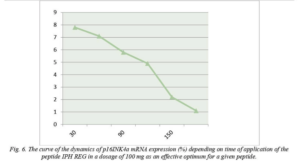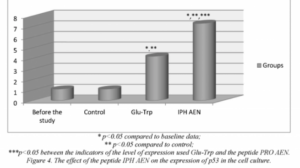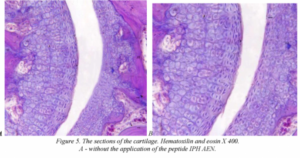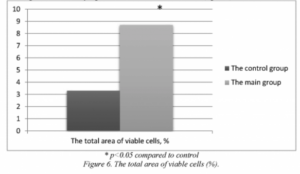
The article describes the result of biological and clinical protective effects of the peptide IPH AEN. The peptide IPH AEN is a high biological activity to the control the normal formation of cartilage and bone tissue, the restoration of the cartilage and bone tissue, as well as confirm information about the cytostatic and oncoprotective properties of the peptide IPH AEN in relation to the human cartilage and bone tissue according to the expression of biological molecules on cell culture. The article proves that the peptide IPH AEN has a normalizing effect on the functional activity of cartilage and bone tissue. The article describes that the application of the peptide IPH AEN leads to the normalization of the structure and thickness of the cartilaginous surface in degenerative-dystrophic lesions of bone and cartilage tissue, which is necessary to maintain the full functionality of the joints. The application of the peptide IPH AEN is recommended as a biologically active food supplement with therapeutic and prophylactic purpose for the normalization of the functions of bone and cartilage tissue according to clinical studies. Keywords: peptide, cartilage and bone tissue, protective effects, biological effects, the peptide IPH AEN.
The study of the effects of peptides has a great interest today. Peptides have the same structure as proteins, but the size of these molecules is smaller. It is also important that short peptides are a natural metabolic product in the body and they can`t be detected in blood or urine. That`s why, it is interesting to study the effects of peptides on cell cultures [1, 2]. The peptide IPH AEN contains a low molecular weight peptide and it has chondroprotective and osteoprotective properties and has a normalizing effect on cartilage and bone tissue [3, 4, 5].
The results of experimental studies have shown that the peptide IPH AEN regulates the metabolic processes in chondrocytes and osteocytes, increases the reserve capacity of the body, which suggests the effectiveness of the peptide IPH AEN to normalize the functions and restore the cartilaginous and skeletal systems in humans in disorders of various origins [1, 5, 6].
The aim of this study was to identify biological and clinical chondroprotective and osteoprotective and other effects of the peptide IPH AEN.
We conducted 3 areas of research to identify the biological and clinical effects of the peptide IPH AEN:
In a cell-based study we selected embryonic stem cells to study the cytostatic, immunomodulatory, geroprotective and oncoprotective properties of the peptide IPH AEN in relation to the bone and cartilage. These cells belong to the pluripotent type, which means that they can be differentiated into all three primary germ sheets: ectoderm, endoderm and mesoderm. Organs of the bone and cartilage and other systems are formed from these primary germ sheets in the future. The human embryo transformes the blastocyst stage in 5-6 days after fertilization. The stem cells are obtained from the blastocyst. The genes responsible for the formation of bone and cartilage are the COMP gene (Transcript: NM_000095) and the COL2A1 gene. Mutations in the cartilage of thrombospondin (COMP) cause achondroplasia and dysplasia, accompanied by the defeat of the large joints. In connection with these data, we decided to study the activity of this gene in the application of the peptide IPH AEN. The gene mutations and changes in COL2A1 gene expression are associated with the severity of degenerative lesions of bone and cartilage. The COL2A1 gene encodes the alpha-1 protein of the type I collagen chain and is potentially significant in the formation of a genetic predisposition to osteoporosis and bone fragility at risk of fractures. We decided to study the activity of this gene in the application of the peptide IPH AEN. We evaluated marker biological active molecules by immunofluorescence method using primary antibodies to MMP13 (1:120, Abcam) and p53 protein (1:50, Abcam). ММР13 protein – a marker of remodeling of the extracellular matrix and the functional activity of chondrocytes. The matrix metalloproteinases (MMP), belonging to the family of zinc metalloproteinases, participate in the exchange of intercellular matrix proteins. The leading role in the process of physiological remodeling of hyaline cartilage of the joint is assigned to metalloproteinases belonging to the class of collagenases (MMP-1, MMP-13, etc.). Normally, metalloproteinases are secreted by fibroblasts, chondrocytes, epithelial cells, macrophages in very small amounts in the inactive state. An important feature of metalloproteinases is their ability to induction under the influence of various factors. The regulation of collagenase activity is carried out by cytokines, growth factors, various chemical compounds (lipopolysaccharides of bacterial origin, etc.), factors affecting the cell membrane. MMP activity is suppressed by tissue inhibitors of metalloproteinases (TIMP), as well as hormones (glucocorticosteroids, etc.). Previously, it was believed that the main role in the destruction of the matrix belongs to MMP-1, then it was established and the important role of MMP-13, which destroys collagen type II, stromelizin, etc. It is known that signal proteins S100A8 and A9 play a significant role in mechanisms of metalloproteinase activation. As a result, NF-kB receptors of synovial fibroblasts are activated, which determines the release of many cytokines, such as IL-6, IL-10, GM-CSF, IL-8 and chemoattractant monocytes, which, in turn, plays a significant role in the activation of metalloproteinases and causes their high activity in osteoarthritis. The aging of polypotent cells in culture is associated with increased activity of the p53 gene. Protein p53 is activated by DNA damage or is a signal of aging cells and violation of their functional activity. P53-dependent apoptosis avoids the accumulation of mutations, and, in the case where they have already arisen, p53-dependent apoptosis allows to eliminate such potentially dangerous to the body.
We have created the following groups for the study: 1 group – the study of molecular expression before the study; 2 group-control (we added the culture medium, incubation with serum albumin); 3 group – we added the control dipeptide Glu-Trp at the concentration of 100 micrograms (mcg); 4 group – we added the peptide IPH AEN at a concentration of 100 micrograms (mcg). We selected the peptide Glu-Trp with the immune properties and well described in the literature as a control.
The PCR method was used to measure the level of gene expression using Novocasta’s reagents and sets of monoclonal antibodies produced by Biosource (Belgium). We used confocal microscope Olympus FluoView FV1000 with indicator of 200, 400, 600. We conducted the measurement of the expression in %.
We have chosen the most commonly used species of laboratory animals for the study for the experiment recommended by the Ministry of Health of the Russian Federation in the Manual for preclinical studies of drugs – rats.
To study the properties of the peptide IPH AEN, we created a model of acetabulum damage. The obtaining a model of linear through bone and cartilage damage of the acetabulum (RF patent No. 2470378) was performed under sterile conditions under general combined anesthesia: zoletil 100 (“Virbac Sante Animale”, France) 8 mg/kg, xylazine 2 % (“Alfasan International B. V.”, Holland) 4.0 mg/kg, intramuscularly. In the area of the femoral neck, the joint capsule was opened and the head dislocated from the acetabulum. Further, with the help of a surgical saw 0.2 mm thick, a transverse cut of the acetabulum was made from the side of its dorsal part to the level of the middle of the articular fossa, after which the head and neck of the femur were resected. We was studied 40 rats aged 13.8±1.2 months and weighing 423.1±7.5 g, which created the conditions of muscle injury. The rats were divided into 2 groups – control (n=20) and main (n=20). All procedures of animal keeping and testing were carried out in accordance with standards ISO 10993-1-2003 and GOST RISO 10993.2-2006. The rats of the main group were given orally through a pipette-dispenser a solution consisting of water for injection in a dosage of 1 ml, in which the lyophilized powder of IPH AEN peptides was dissolved in a concentration of 0.60 micrograms (mcg) per rat body weight per day for 14 days. A pipette-dispenser allowed to control the volume and the fact of liquid consumption.
The rats were killed after 14 days. Then the joint capsule was removed, fixed by immersion in a solution of 4% paraformaldehyde in phosphate buffer (PBS pH = 7.3) for 24 hours at a temperature of 4 °C. We produced slices with a thickness of 20 µm using cryotome of Leica CM 1510S model (Germany). Then the sections were mounted on a slide and stained with hematoxilin and eosin. We used the Olympus IX81 microscope for the study. The Danet criterion was used to assess the reliability of the difference in the results obtained in the groups before the application of the peptide, compared with the groups after the application of the peptide IPH AEN.
The clinical studies of the peptide IPH AEN were conducted in 88 patients aged 28 to 60 years (mean age was 39.7±1.2 years) with the damage to the knee joint. The inclusion criteria: the patients with chondropathy of knee joints of III degree, osteoarthritis of knee joints of 1-2 degree. The exclusion criteria: acute diseases, patients with decompensated pathology, patients with exacerbation of chronic diseases.
We conducted studies the effectiveness of peptides in the dosage of 50 µg (n= 86 people) and 150 µg (n=87 people) to assess the effectiveness of the dose of 100 µg (n=88 people) for the peptide IPH AEN. The peptide IPH AEN was administered orally: 1 capsule (100 µg peptide) 1 time per day for 30 days, then 30 days a break in the medication. And repeat the same course for another 30 days, again 30 days a break in the medication – and the third course for 30 days. The total course was 6 months (3 courses of 30 days and 3 a break in the medication of 30 days). We studied the efficacy of the IPH AEN peptide was evaluated based on the level of calmodulin in buccal epithelium. A decrease of this protein is detected when cartilage tissue is damaged and leads to decrease function of regeneration and repair. The norm of calmodulin level (Anti – CalEF-hand antibody) in buccal epithelium (25-60 years): 7.8 – 14.6 conventional units (c.u.). The effectiveness of the IPH AEN peptide was also evaluated on the basis of subjective sensations (using VAS – visual analog scale) and the hyaline cartilage of the knee joints was assessed by ultrasonography on the Samsung SonoAce R3 using a high-frequency linear sensor with a frequency of 7.5 – 10.0 MHz. The structure and thickness of the hyaline cartilage of the femoral condyles of the injured knee joint were evaluated with the calculation of the index of degenerative thinning of the cartilage by the ratio of the thickness of the hyaline cartilage of the loaded surface to the thickness of the cartilage of the posterior surface of the femoral condyle.
We used standard statistical methods of medical and biological research.
Results and discussion.
The biological analysis of chondroprotective and osteoprotective effects of the peptide IPH AEN on cell culture

In figure 1 we show that the peptide IPH AEN significantly increases the expression of the gene COMP, responsible for the normal formation and formation of bone and cartilage tissue, in particular, regulating metabolism (metabolism) in bone and cartilage tissue and it provides a protective action against joint damage in humans, that is, the peptide IPH AEN provides degenerative processes in cartilage tissue of the joints thereby providing prevention of joint diseases.

In figure 2 we show that the peptide IPH AEN significantly increases the expression of the gene COL2A1, controlling degenerative lesions of cartilage, in particular, significant in the formation of genetic predisposition to osteoporosis and bone fragility with the risk of fractures.
Thus, the influence of the peptide IPH AEN in human cell culture there is a statistically significant increase in the expression of genes responsible for the ontogenesis of bone and cartilage tissue, namely the synthesis of cartilage cells, which provides rapid regeneration of bone tissue, improves the production of collagen and hyaluronic acid. These data show that the peptide IPH AEN significantly increases in human cell culture “cascade” of signal molecules, which is necessary to activate the processes of proliferation and differentiation of stem cells in the cells of cartilage, the formation of cartilage systems, regulation of metabolism in cartilage tissue and providing protective effects against the joint damage, control of degenerative lesions of cartilage tissue, osteoporosis and bone fragility with the risk of fractures in humans.

Figure 3 shows that the application of the peptide IPH AEN increases the expression of MMP13 in 9,6 times from the initial level, which is a key factor in the remodeling of the intercellular matrix and functional activity of chondrocytes, thereby regulating the synthesis of cartilage cells and providing rapid regeneration of bone tissue.

Thus, the application of the peptide IPH AEN provides chondroprotective and osteoprotective effects, in particular, induces differentiation of polypotent chondrogenic and osteogenic cells in the direction of normal formation of cartilage tissue and its regeneration. In particular, these data indicate that the application of the peptide IPH AEN provides synthesis of cartilage cells and rapid regeneration of bone tissue, which leads to the maintenance of full functionality of the joints.
The effect of the peptide IPH AEN on the expression of p53 protein in cell cultures is presented in figure 4. The application of the peptide IPH AEN increases the production of protein p53, which is a transcriptional factor and acts as a suppressor of malignant tumor formation by the way of activating apoptosis in the tissues. This results lead to the conclusion about the antitumor properties of the peptide IPH AEN.

P53-dependent apoptosis also avoids the accumulation of mutations. In the case when mutations have already arisen, p53-dependent apoptosis allows to eliminate this potentially dangerous cells. On this fact we can make a conclusion about the cytoprotective effect of the peptide IPH AEN.
The peptide IPH AEN had a high onco-protective activity in relation to the cells of the bone and cartilage tissue according to the expression of biological molecules in cell culture.
Biological analysis of chondroprotective and osteoprotective effects of the peptide IPH AEN in an experimental model
During the experiment it was shown that the use of the peptide IPH AEN significantly increases the reparative properties of cartilage. When we used this peptide, it was noted that the zone of damage was filled with granulation tissue with a large number of thin-walled capillaries lined from the inside with flattened nucleated endothelial cells. On the surface of the injured bone trabeculae there were active osteoblasts, few osteoclasts were found. In the bone tissue of the fragments near the line of damage, nucleated osteocytes were determined, on the periosteal and endosteal surfaces active osteoblasts. While in control group it was found that the diastasis between the injury was filled with fibrin and tissue detritus, including fields of changed necrotic cells with a pronounced karyopyknosis or karyolysis. The cell composition was dominated by cells characteristic of the inflammatory stage of the reparative process – segmental leukocytes and mononuclear phagocytes (figure 5).

B with the application of the peptide IPH AEN. The application of the peptide IPH AEN improves
repair and regeneration of bone and cartilage tissue after damage, reduces the degree of inflammatory reaction, in other words, the peptide IPH AEN has a high reparative and regenerative activity against bone and cartilage tissue and has anti-inflammatory properties, as well as counteracting degenerative processes in the cartilaginous tissue of the joints thereby providing prevention of diseases of the joints.
During the experiment we revealed the total area of viable cells (figure 6).

The application of peptide IPH AEN increases the total area of viable cells in 2,7 times. These data confirm the fact that the application of the peptide IPH AEN helps to improve the regeneration and restoration of bone and cartilage tissue, the synthesis of cartilage cells, which provides rapid regeneration of bone tissue, improves the production of collagen and hyaluronic acid after damage on the experimental model.
Clinical analysis of chondroprotective and osteoprotective effects of the peptide IPH AEN
The results of a clinical study of the application of peptide IPH AEN showed that in patients in 3 months after the application of this peptide significantly improved subjective assessment of pain in 1.4 times (table 1).

The application of the peptide IPH AEN leads to a decrease in the inflammatory reaction and thus to a decrease in pain, observed in patients with degenerative – dystrophic lesions of bone and cartilage.
The application of the peptide IPH AEN increases the expression of the molecular marker of calmodulin to the upper limit of the norm. At the same time, at the beginning of the study, the level of calmodulin was reduced due to the presence of degenerative cartilage lesions in the studied patients (table 2).

Thus, we have found that the application of the peptide IPH AEN contributes to a significant improvement in the regeneration and repair of bone and cartilage tissue in degenerative lesions of bone and cartilage tissue, as well as counteracts degenerative processes in the cartilage tissue of the joints, thereby ensuring the prevention of joint diseases.
The dynamics of the index of degenerative thinning of cartilage is shown in table 3.

The application of the peptide IPH AEN led to the positive dynamics of the ultrasound examination: the echogenicity decreased and the contours of the articular cartilage became clearer, the degenerative thinning of the cartilage decreased in 0,9 times. These data indicate that the application of the peptide IPH AEN leads to the normalization of the structure and thickness of the cartilage surface in degenerative dystrophic lesions of bone and cartilage tissue, which is necessary to maintain the full functionality of the joints.
We haven`t found significant differences between the results in the application of 100 mcg and 150 mcg in all the studied parameters like in 3 months as in 6 months. Also, we have not found significant differences between the indicators in the application of 50 mcg and before the study on all parameters. This fact proves that the effective optimal dosage for the peptide IPH AEN is 100 mcg
The studies confirm the high biological activity of the peptide IPH AEN in relation to the normal formation of bone and cartilage tissue, regulation of metabolism in cartilage tissue and the provision of a protective action against joint damage in humans, as well as control of the development of degenerative lesions of cartilage tissue, in particular, with osteoporosis and injuries. The peptide IPH AEN counteracts degenerative processes in the cartilage of the joints, thereby providing prevention of joint diseases. After the application of the peptide IPH AEN there is a statistically significant increase in the expression of genes responsible for the ontogenesis of bone and cartilage tissue, namely the synthesis of cartilage cells, which provides rapid regeneration of bone tissue, improves the production of collagen and hyaluronic acid. These data show that the peptide IPH AEN significantly increases in human cell culture “cascade” of signal molecules, which is necessary to activate the processes of proliferation and differentiation of stem cells in the cells of cartilage, the formation of cartilage systems, regulation of metabolism in cartilage tissue and providing protective effects against joint damage, control of degenerative lesions of cartilage tissue, osteoporosis and bone fragility with the risk of fractures in humans. The application of the peptide IPH AEN has chondroprotective and osteoprotective effects, in particular, induces differentiation of polypotent chondrogenic and osteogenic cells in the direction of normal formation of cartilage tissue and its regeneration. In particular, these data indicate that the application of the peptide IPH AEN provides synthesis of cartilage cells and rapid bone regeneration, which leads to the maintenance of full functionality of the joints. The data indicate a high onco-protective activity of the peptide IPH AEN in relation to the cells of the cartilage according to the expression of biological molecules in cell culture.
The application of the peptide IPH AEN improves repair and regeneration of bone and cartilage tissue after damage, reduces the degree of inflammatory reaction, in other words, the peptide IPH AEN has a high reparative and regenerative activity against bone and cartilage tissue and has anti-inflammatory properties, and also counteracts degenerative processes in the cartilaginous tissue of the joints thereby providing prevention of joint diseases. The application of the peptide IPH AEN increases the total area of vital cells in 2,7 times. These data confirm the fact that the application of the peptide IPH AEN helps to improve the regeneration and restoration of bone and cartilage tissue, the synthesis of cartilage cells, which provides rapid regeneration of bone tissue, improves the production of collagen and hyaluronic acid after damage on the experimental model.
According to clinical data, the application of the peptide IPH AEN leads to a decrease in the inflammatory reaction and thus to a decrease in pain, observed in patients with degenerative – dystrophic lesions of cartilage. The application of the peptide IPH AEN contributes to a significant improvement in the regeneration and repair of bone and cartilage tissue in degenerative
dystrophic lesions of bone and cartilage tissue, and also counteracts degenerative processes in the cartilage tissue of the joints, thereby ensuring the prevention of joint diseases. The application of the peptide IPH AEN leads to the normalization of the structure and thickness of the cartilaginous surface in degenerative-dystrophic lesions of bone and cartilage tissue, which is necessary to maintain the full functionality of the joints. The application of the peptide IPH AEN is recommended as a biologically active food supplement with therapeutic and prophylactic purpose for the normalization of the functions of bone and cartilage tissue.
 IPH – PEPTIDES
Read more
IPH – PEPTIDES
Read more